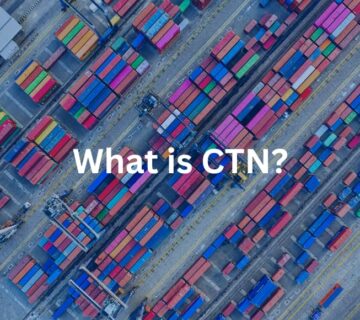International shippers often encounter the ECTN certificate, which is essential for moving goods into many African countries. ECTN stands for Electronic Cargo Tracking Note – a digital document containing detailed shipment information required by certain nations for import clearance.
In practice, it functions as an advance cargo declaration, helping authorities track shipments, ensure correct duties, and curb smuggling or fraud. This article explains what is an ECTN for Africa, how to obtain an ECTN certificate, and offers a step-by-step guide through the process. It’s written for a broad audience including freight forwarders, exporters, importers, logistics companies, and anyone who needs to secure an ECTN certificate (or its equivalents) for their shipments.
ECTN Meaning: The ECTN for Africa is known by different names in different places there. You might hear it called a CTN certificate (Cargo Tracking Note) or, in French-speaking regions, a BESC certificate (Bordereau Électronique de Suivi de Cargaison) or BSC certificate (Bordereau de Suivi de Cargaison). In the Democratic Republic of Congo it’s termed a FERI certificate, in Gabon a BIETC certificate, and in Angola a CNCA certificate – but all refer to the same concept.
Even other certificates like ACID (Egypt’s Advance Cargo Information system) or an ACD (Advanced Cargo Declaration) serve a similar purpose of tracking cargo. No matter the acronym, these certificates are mandatory for imports in the countries that require them and must be obtained before the goods arrive. Failing to have the proper CTN can lead to severe consequences – shipments may be delayed, fined, or even refused entry.
What's in the Article?
- What is an ECTN (Electronic Cargo Tracking Note) Certificate?
- African Countries That Require an ECTN/CTN/BESC Certificate
- Documentation Required for an ECTN Application
- ECTN Application and Verification Process
- Step-by-Step Guide to Obtaining an ECTN Certificate
- Fees and Costs for ECTN Certificates
- Final Steps: Attaching the ECTN Certificate and Customs Clearance
What is an ECTN (Electronic Cargo Tracking Note) Certificate?
An ECTN certificate or ECTN Waiver is an official electronic document that contains key details about a cargo shipment. It typically includes information such as the shipper and consignee, the cargo’s origin and destination, the vessel/voyage, a description of the goods (with HS codes, weight, and value), and transport details. Once issued, the certificate is assigned a unique number that is used by customs to track and verify the shipment. The document essentially acts as a cargo tracking note or waiver document required by the destination country’s customs. Its primary purposes are:
- Customs Compliance: It provides customs authorities with advance information about the shipment, which speeds up clearance and ensures proper import duties/taxes are assessed.
- Cargo Tracking: It enables the destination country to electronically track the cargo from origin to arrival, improving transparency.
- Security and Fraud Prevention: By detailing the cargo’s contents and value, ECTN documentss help prevent under-declaration of goods, smuggling, and other illicit activities.
- Statistical and Planning Data: Authorities use the data to anticipate port logistics (knowing what is arriving) and to collect trade statistics.
In summary, an ECTN for Africa (or CTN/BESC/BSC) certificate is a digital cargo document required for import into certain countries, ensuring that all shipments are properly declared and monitored in advance. Even though names like CTN, BESC, BSC, FERI, BIETC may vary by country, they all refer to this electronic cargo tracking certificate requirement.
African Countries That Require an ECTN/CTN/BESC Certificate
Many African countries mandate an ECTN certificate or similar certificate for incoming shipments. The list of countries can evolve, but as of the latest information, the following countries require an ECTN waiver (or an equivalent Cargo Tracking Note document) for imports.
- Algeria ECTN (Electronic Cargo Tracking Note)
- Angola CNCA / ARCCLA
- Benin BESC
- Burkina Faso ECTN (sometimes called URN for Unique Reference Number)
- Burundi ECTN
- Cameroon BESC
- Central African Republic ECTN
- Chad ECTN
- Democratic Republic of Congo (DRC) FERI (Fiche Électronique de Renseignements à l’Importation)
- Republic of Congo (Congo-Brazzaville) ECTN
- Djibouti ECTN
- Egypt ACID (Advance Cargo Information Declaration)
- Equatorial Guinea ECTN
- Gabon BIETC (Bordereau d’Identication Électronique de Traçabilité des Cargaisons)
- The Gambia CTN (Cargo Tracking Note)
- Ghana CTN
- Guinea (Conakry) ECTN
- Guinea-Bissau ECTN/CEE (Certificado Eletrónico de Embarque)
- Ivory Coast (Côte d’Ivoire) BSC (Bordereau de Suivi de Cargaison)
- Liberia CTN
- Libya ECTN
- Madagascar BSC
- Mali BSC
- Niger BSC
- Nigeria ICTN (International Cargo Tracking Note)
- Senegal BSC
- Sierra Leone BSC or ENS
- Somalia ECTN
- South Sudan ECTN
- Togo ECTN
- Yemen ACD
Each country’s program has its own nuances (name, issuing platform, fees, etc.), but all serve the same function of pre-registering cargo information. Always check the current requirement for your specific destination before shipping, as regulations can change and new countries may introduce ECTN certificate rules. Not having the required certificate for these destinations can result in penalties, cargo being held, or refusal of entry, so it’s crucial to know when it’s needed.
Documentation Required for an ECTN Application
To apply for an ECTN certificate, you will need to gather several key shipping documents in advance. Having complete and correct documentation is critical, as the ECTN document details must match the actual shipment documents exactly. The common required documents for an ECTN application include:
- Commercial Invoice: The invoice for the goods, showing the cargo’s value, seller, buyer, and a description of the goods.
- Bill of Lading (BL): The bill of lading or sea waybill issued by the carrier, containing details like the shipper, consignee, vessel, voyage, ports of loading and discharge, container numbers (if any), weight, and cargo description.
- Packing List: A detailed packing list describing the contents of each package or container, including weights and dimensions.
- Freight Invoice: If the freight cost is not shown on the commercial invoice, a separate freight cost invoice (from the carrier or forwarder) may be required to document the shipping charges.
- Export Customs Declaration: In some cases, a copy of the export customs declaration (from the origin country) is requested to verify the cargo details and origin.
- Others (if applicable): Some countries might ask for additional paperwork such as a certificate of origin, import license, or insurance certificate, depending on the nature of the goods.
It’s best to prepare digital copies (PDF or scanned images) of these documents, since the ECTN application is done online by uploading these files. Ensure all information is clear and matches across documents (for example, the gross weight on the invoice, packing list, and BL should be the same). Incomplete or incorrect documentation is one of the main causes of delays or rejections in the process.
According to a global ECTN guide, the key documents you’ll typically need are the commercial invoice, the bill of lading, the freight invoice, and the packing list. Having these ready will make the application smoother.
ECTN Application and Verification Process
How do you actually obtain the ECTN certificate? The entire process is handled by Global CTN, an authorized ECTN agent. We take care of everything from start to finish, ensuring a smooth and compliant certification for your shipment.
Step 1: Contact Global CTN
You (or your freight forwarder) simply need to reach out to us. Global CTN is an authorized agent for multiple countries, and we are responsible for managing the certification process on your behalf.
Step 2: We Handle the Application
Once you provide us with your shipment details—such as the shipper and consignee names, vessel and voyage number, ports of loading and discharge, container numbers, goods description, HS codes, quantity, weight, value, and other relevant information—our team will prepare and submit the application on your behalf. We ensure accuracy and compliance with the destination country’s regulations.
Step 3: Document Processing
You send us the required shipping documents, such as the Bill of Lading, commercial invoice, and packing list. Global CTN will review everything, match it with the shipment details, and take care of all necessary validations. Any discrepancies will be clarified and resolved directly with you.
Step 4: Payment and Verification
We will provide the payment instructions based on the destination country’s requirements. After payment, we coordinate the official verification process with the designated authorities. If a draft certificate is issued, we will review it with you to ensure all information is correct before final approval.
Step 5: Issuance of the ECTN Certificate
Once verified, the ECTN certificate is officially issued. We will send you the validated certificate, including the unique ECTN number, which you can then share with the consignee, shipping line, and any party involved in customs clearance. The ECTN number must be included in the shipping documents, such as the Bill of Lading or manifest, to ensure smooth clearance at the destination.
The entire online application and verification process can typically be completed within a few days if all goes well, but it requires careful attention. Always aim to do this before the cargo arrives at port – in fact, it’s best done shortly after the bill of lading is issued, so that there’s buffer time for any issues. If you stay proactive and responsive to any queries from the ECTN issuing agency, you can obtain the certificate without delaying your shipment.
Step-by-Step Guide to Obtaining an ECTN Certificate
For clarity, here is a step-by-step guide summarizing how to obtain an ECTN certificate from start to finish:
- Gather Your Documents.
- Register with an Authorized Agent.
- Complete the ECTN Application Form.
- Submit the Required Documents.
- Submit the Application and Pay the Fee.
- Application Verification.
- Receive the ECTN Certificate.
- Attach the ECTN to Shipping Documents.
- Present for Customs Clearance.
These steps cover the typical procedure to obtain an ECTN/BESC certificate. The key is to be thorough and proactive at each step – prepare documents, fill in accurate data, and don’t delay on payment or follow-ups. By following this guide, freight forwarders and shippers can navigate the ECTN application with minimal hassle.
Fees and Costs for ECTN Certificates
One important aspect of the ECTN process is the fee. Obtaining an ECTN certificate is not free – each certificate comes with a cost that can vary significantly by country and shipment. When planning your logistics, you should factor in these fees to avoid surprises.
- ECTN Fees by Country: ECTN (Electronic Cargo Tracking Note) costs vary by destination. Some countries charge a flat rate (e.g. $100 per shipment), while others use cargo value, weight, or container count to calculate fees. South Sudan, for example, charges a high flat fee of $350 per shipment. Others like Cameroon or Ivory Coast may use a mix of base fees and cargo-based surcharges. Always check the official ECTN portal or issuing agent for the latest rates.
- What ECTN Fees Cover: The ECTN fee covers the certificate and administrative costs of cargo tracking. It’s separate from customs duties or port charges and is mandatory for compliance.
- How to Pay: ECTN payment must be completed for validation. Payment options include credit card, bank transfer, or local agent payment. Some countries require payment in a specific currency (USD or EUR). Follow the issuing authority’s instructions to avoid delays.
- Extra Agent Fees: Using a freight forwarder or third-party agent may add a service fee on top of the ECTN cost. Major carriers may also offer ECTN services for an added charge. Always ask for the full breakdown upfront.
- Typical ECTN Cost Range: ECTN fees range from $30 to over $350 per shipment, depending on the country and cargo. Most fall under $150. Always research your destination’s requirements early to budget accurately.
- Plan Ahead: Include ECTN fees in your shipping quote. Late applications can lead to rush fees or fines. Missing an ECTN may result in extra penalties and shipment delays. Apply early to avoid issues.
In summary, ECTN fees are an important cost factor in shipping to certain African countries. They vary widely by country and are often proportional to your cargo or have fixed rates. Make sure to verify the fee structure for your specific route, pay the fee on time, and incorporate it into your overall logistics budget.
Final Steps: Attaching the ECTN Certificate and Customs Clearance
After successfully obtaining the ECTN certificate, there are a few final steps to ensure your shipment clears customs smoothly at the destination:
- Include the ECTN Number on Shipping Documents: Most countries require that the ECTN number is noted on the Bill of Lading or cargo manifest. This is how the port authorities know an ECTN has been filed for that shipment. If you received the ECTN number after the BL was issued, inform your shipping line and the consignee of the number. The carrier might update the manifest or at least have a record of it. Some countries’ customs systems automatically link the ECTN with the manifest if the number is provided.
- Attach the ECTN Certificate Printout: It’s good practice to print out the ECTN certificate (the PDF document) and include it with the physical documents (like the original BL or other papers) that travel with the shipment or are sent to the consignee. Even though ECTN is an electronic document, having a printed copy can be helpful for the consignee’s customs broker during clearance, especially if they need to show it to any officials.
- Consignee Preparation: Make sure the importer/consignee knows that an ECTN is in place and has the certificate or at least the reference number. Often, the consignee or their customs clearing agent will be the one to present the ECTN to the customs authorities. Provide them with all the details they might need (for instance, the ECTN reference, date of issuance, and the issuing agency’s name). This will help them verify it on their side.
- Customs Verification: Upon arrival of the goods, during the customs clearance process, the customs officers will verify the ECTN. This might be done electronically (they check in their system using the ECTN number) or manually by inspecting the certificate. They will look to confirm that the ECTN is authentic, corresponds to that shipment, and was obtained before arrival. Since the ECTN contains detailed cargo info, customs uses it to cross-check the declaration made by the importer.
- Clearance and Release: If the ECTN is valid and everything matches, the shipment proceeds with the normal customs clearance (payment of duties, inspections if any, etc.). With the ECTN in hand, this process is usually straightforward, since the data was pre-registered and any issues likely resolved beforehand. Once duties are paid and documents are in order, the goods are released to the importer.
- If No ECTN or Issues: It’s worth noting what happens if these final steps are not in place. If a shipment arrives without a required ECTN certificate, the customs will typically hold the cargo. The importer would then have to scramble to obtain a retrospective ECTN (often incurring a penalty for late filing). This can lead to significant delays, storage fees at the port, and fines. In worst cases, heavy non-compliance fines are levied, or the cargo might even be sent back. That’s why obtaining and attaching the ECTN well in advance is so important. As Maersk notes in its guidance, the ECTN must be obtained and paid for beforehand, and then presented to customs during clearance.
- Carrier Requirements: Some shipping lines will not load a container for an ECTN-required destination unless you provide the ECTN number (or proof that it’s being processed). This is not universal, but it’s another reason to get the ECTN done early and share the reference with the carrier. It ensures the carrier is satisfied that the shipment won’t face issues on arrival.
In summary, the final step is all about making use of the ECTN you obtained: incorporate it into your documentation flow and ensure the right parties have it. With the certificate attached and its number communicated, your shipment will be ready for smooth customs clearance. The ECTN essentially becomes one of the key documents (like the BL or commercial invoice) that customs must see to release the cargo.






